overheating BUICK CENTURY 1996 Owners Manual
[x] Cancel search | Manufacturer: BUICK, Model Year: 1996, Model line: CENTURY, Model: BUICK CENTURY 1996Pages: 340, PDF Size: 17.61 MB
Page 111 of 340
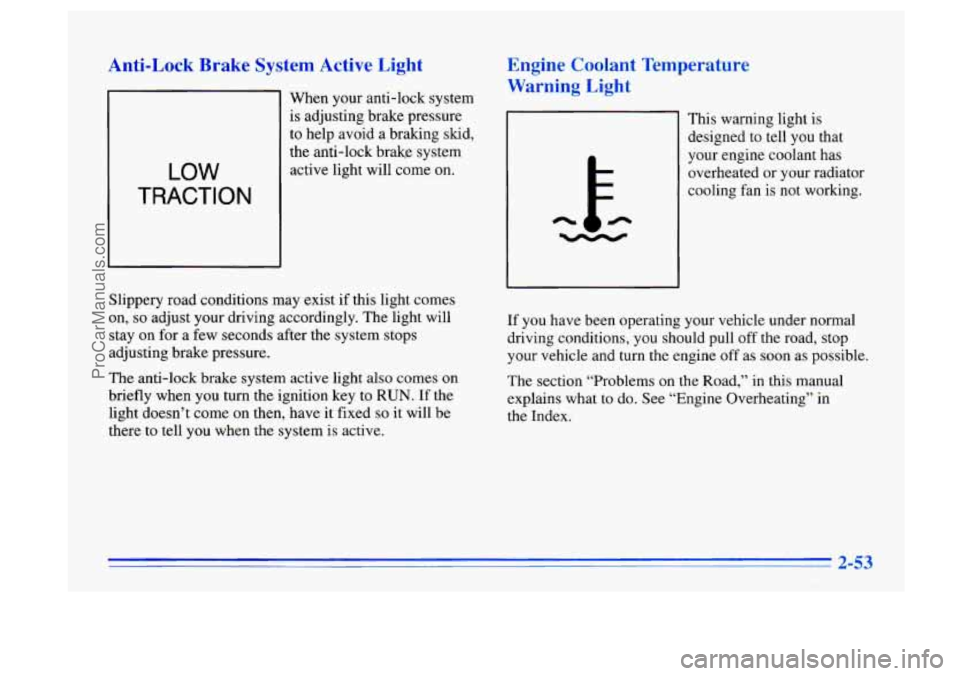
Anti-Lock Brake S A
LOW
TRACTION
When your anti-lock system
is adjusting brake pressure
to help avoid a braking skid,
the anti-lock brakg system active light will come on.
Slippery road conditions may exist if this light comes
on,
so adjust your driving accordingly. The light will
stay
on for a few seconds after the system stops
adjusting brake pressure.
The anti-lock brake system active light also comes on
briefly when
you turn the ignition key to RUN. If the
light doesn’t come
on then, have it fixed so it will be
there to tell you when the system
is active.
Engine Coolant Temperature
Warning
Light
This warning light is
designed to tell you that
your engine coolant has
overheated or your radiator
cooling fan is not working.
If you have been operating your vehicle under normal
driving conditions, you should pull
off the road, stop
your vehicle and turn the engine off as soon as possible.
The section “Problems on the Road,” in this manual
explains what to do. See “Engine Overheating” in
the Index.
2-53
ProCarManuals.com
Page 112 of 340
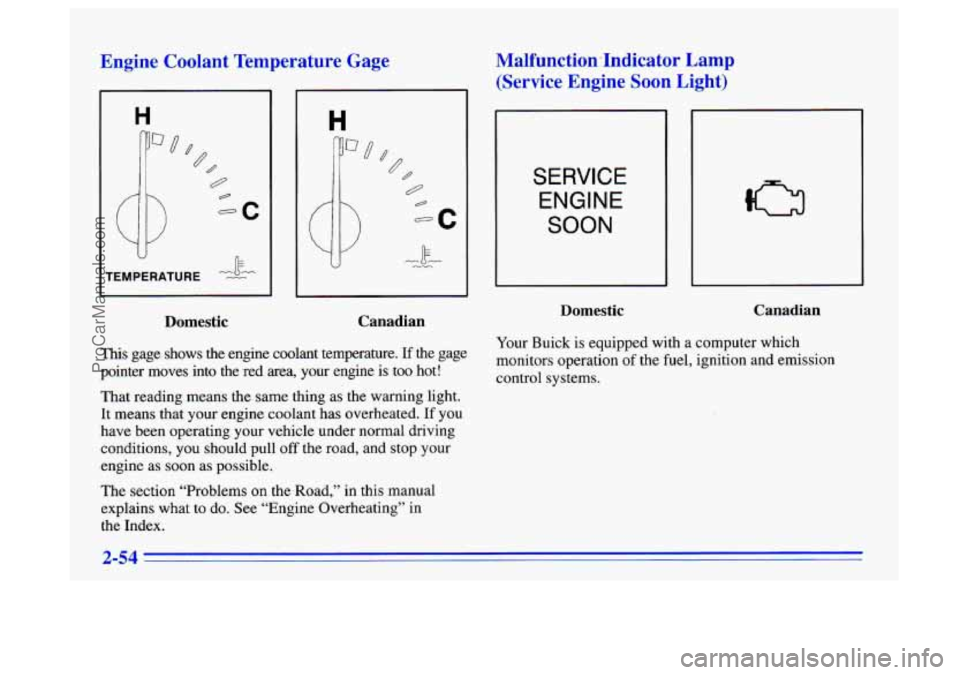
Engine Coolant Temperature Gage
II k
TEMPERATURE -Z
Domestic Canadian
This
gage shows the engine coolant temperature. If the gage
pointer moves into the red area, your engine is too hot!
That reading means the same thing
as the warning light.
It means that your engine coolant has overheated. If you
have been operating your vehicle under normal driving
conditions, you should pull off the road, and stop your
engine as soon as possible.
The section “Problems on the Road,” in this manual
explains what to do. See “Engine Overheating” in
the Index.
Malfunction.Indicator Lamp
(Service Engine Soon Light)
SERVICE
ENGINE
SOON
Domestic Canadian
Your
Buick is equipped with a computer which
monitors operation
of the fuel, ignition and emission
control systems.
2-54
ProCarManuals.com
Page 165 of 340
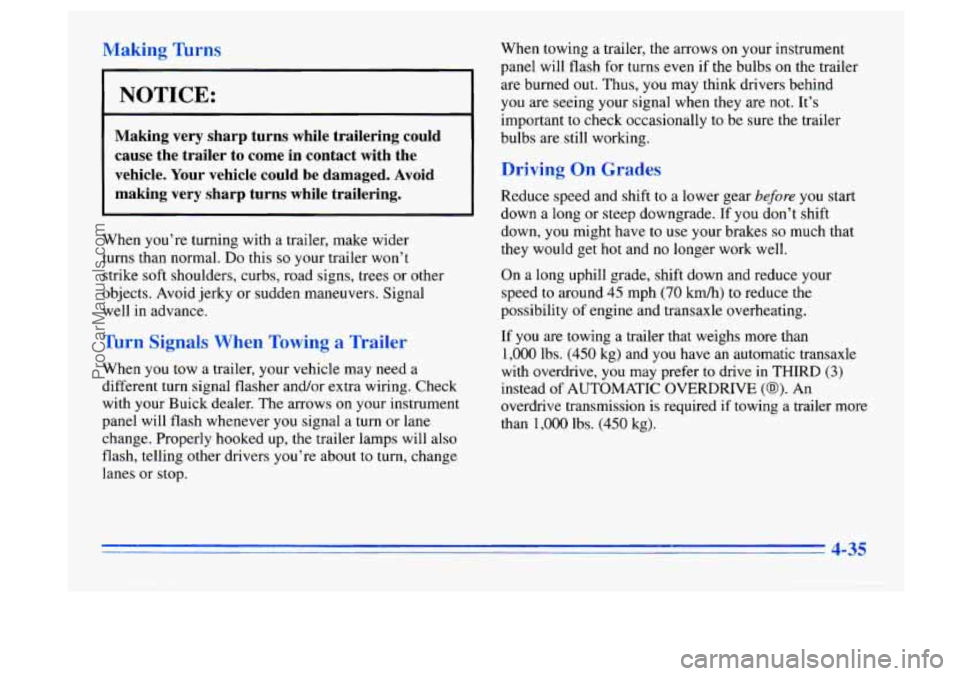
Making Turns
I NOTICE:
Making very sharp turns while trailering could cause the trailer to come in contact with the
vehicle. Your vehicle could be damaged. Avoid
making very sharp turns while trailering.
When you’re turning with a trailer, make wider
turns than normal.
Do this so your trailer won’t
strike soft shoulders, curbs, road signs, trees or other
objects. Avoid jerky or sudden maneuvers. Signal
well in advance.
Turn Signals When Towing a Trailer
When you tow a trailer, your vehicle may need a
different turn signal flasher and/or extra wiring. Check
with your Buick dealer. The arrows on your instrument
panel will flash whenever
you signal a turn or lane
change. Properly hooked up, the trailer lamps will also
flash, telling other drivers you’re about
to turn, change
lanes or stop. When towing
a trailer, the arrows on your instrument
panel will flash for turns even if the bulbs on the trailer
are burned
out. Thus, you may think drivers behind
you are seeing your signal when they are not. It’s
important to check occasionally to be sure the trailer
bulbs are still working.
Driving On Grades
Reduce speed and shift to a lower gear before you start
down a long or steep downgrade. If you don’t shift
down, you might have
to use your brakes so much that
they would get hot and no longer work well.
On a long uphill grade, shift down and reduce your
speed to around
45 mph (70 km/h) to reduce the
possibility
of engine and transaxle overheating.
If you are towing a trailer that weighs more than
1,000 lbs. (450 kg) and you have an automatic transaxle
with overdrive, you may prefer to drive in
THIRD (3)
instead of AUTOMATIC OVERDRIVE (@I). An
overdrive transmission is required if towing a trailer more
than
1,000 lbs. (450 kg).
4-35
ProCarManuals.com
Page 179 of 340
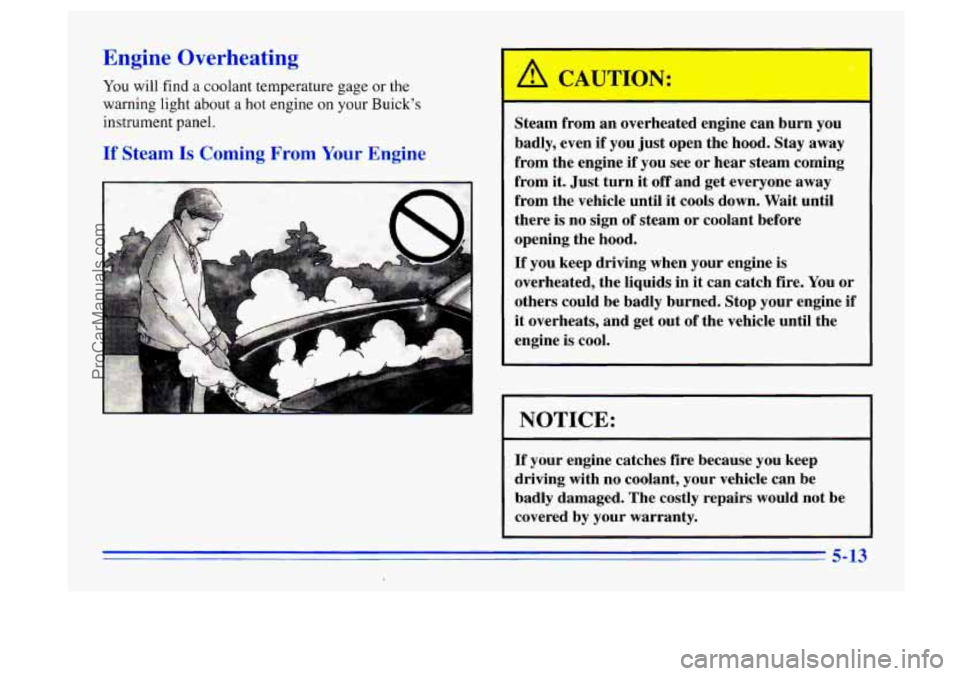
Engine Overheating
You will find a coolant temperature gage or the
warning light about a hot engine on
your Buick’s
instrument panel.
If St1 .-m Is 1 - - ng Fro Your Engine
Steam from an overheated engine can burn you
badly, even if you just open the hood. Stay away
from the engine if you see or hear steam coming
from it. Just turn
it off and get everyone away
from the vehicle until
it cools down. Wait until
there is no sign of steam or coolant before
opening the hood.
If you keep driving when your engine is
overheated, the liquids in it can catch fire. You or
others could be badly burned. Stop your engine if
it overheats, and get out of the vehicle until the
engine is cool.
NOTICE:
If your engine catches fire because you keep
driving with no coolant, your vehicle can be
badly damaged. The costly repairs would not be
covered by your warranty.
5-13
ProCarManuals.com
Page 183 of 340
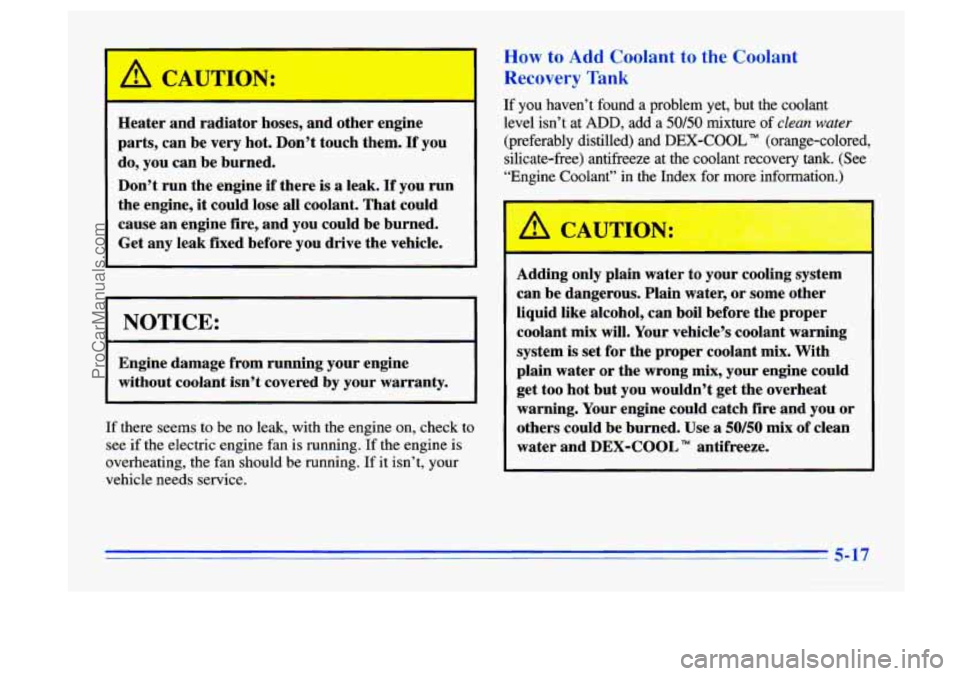
A C U-ION:
Heater and radiator hoses, and other engine
parts, can be very hot. Don’t touch them.
If you
do, you can be burned.
Don’t run the engine if there
is a leak. If you run
the engine,
it could lose all coolant. That could
cause an engine fire, and you could be burned.
Get any leak fixed before you drive the vehicle.
NOTICE:
Engine damage from running your engine
without coolant isn’t covered by your warranty.
If there seems to be no leak, with the engine on, check to
see if the electric engine fan is running. If the engine is
overheating, the fan should
be running. If it isn’t, your
vehicle needs service.
How to Add Coolant to the Coolant
Recovery Tank
If you haven’t found a problem yet, but the coolant
level isn’t at ADD, add a
50/50 mixture of clean water
(preferably distilled) and DEX-COOL (orange-colored,
silicate-free) antifreeze at
the coolant recovery tank. (See
“Engine Coolant” in the Index for more information.)
Adding only plain water to your cooling system
can be dangerous. Plain
water, or some other
liquid like alcohol, can boil before the proper
coolant mix will. Your vehicle’s coolant warning
system
is set for the proper coolant mix. With
plain
water or the wrong mix, your engine could
get too hot but you wouldn’t get the overheat
warning. Your engine could catch fire and you or
others could be burned. Use
a 50/50 mix of clean
water and DEX-COOL
TM antifreeze.
5-17
ProCarManuals.com
Page 230 of 340
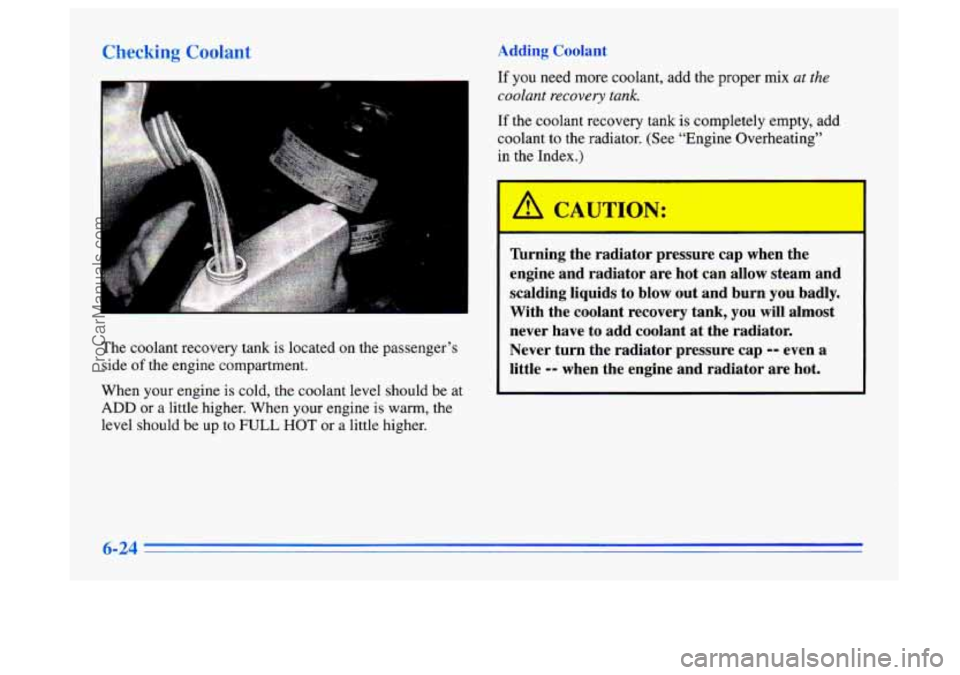
rhacking Coc’mt * clding Coolant
!
The coolant recovery tank is located on the passenger’s
side
of the engine compartment.
When your engine is cold, the coolant level should be at
ADD or a little higher. When your engine is warm, the
level should be up to
FULL HOT or a little higher.
.
If you need more coolant, add the proper mix at the
coolant recovery tank.
If the coolant recovery tank is completely empty, add
coolant to the radiator. (See “Engine Overheating”
in the Index.)
I-
Thrning the radiator pressure cap when the
engine and radiator are hot can allow steam and
scalding liquids to blow out and burn you badly.
With the coolant recovery tank, you
will almost
never have to add coolant at the radiator.
Never turn the radiator pressure
cap -- even a
little
-- when the engine and radiator are hot.
ProCarManuals.com
Page 231 of 340
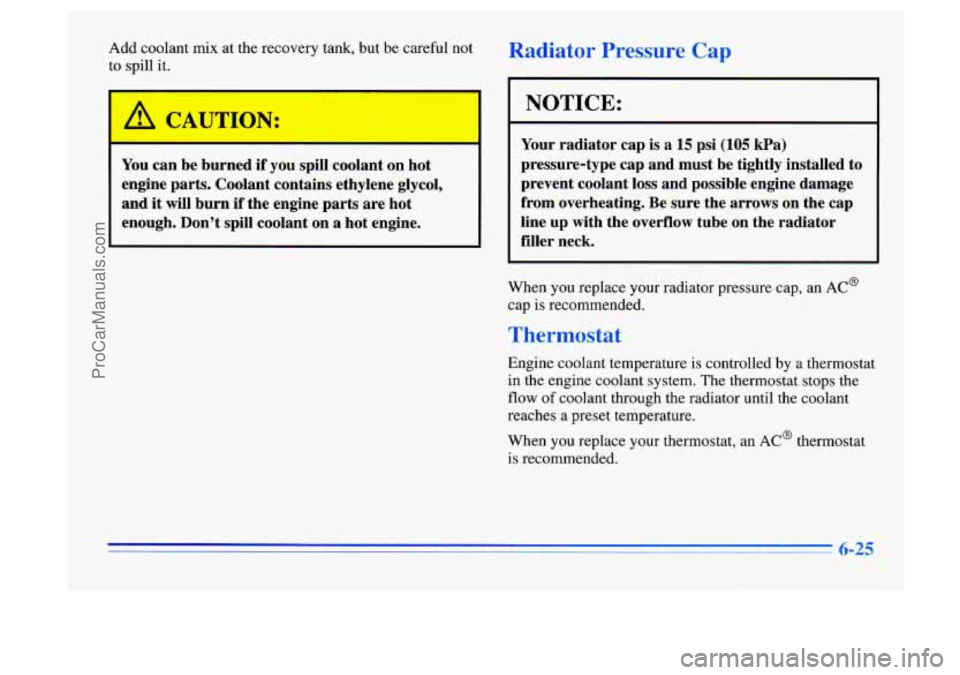
Add coolant mix at the recovery tank, but be careful not
to spill it.
'B CAUTION:
You can be burned if you spill coolant on hot
engine parts. Coolant contains ethylene glycol,
and
it will burn if the engine parts are hot
enough. Don't spill coolant on a hot engine.
Radiator Pressure Cap
NOTICE:
Your radiator cap is a 15 psi (105 kPa)
pressure-type cap and must be tightly installed to
prevent coolant loss and possible engine damage
from overheating. Be sure the arrows on the cap
line up with the overflow tube on the radiator
filler neck.
When you replace your radiator pressure cap, an AC@
cap is recommended.
Thermostat
Engine coolant temperature is controlled by a thermostat
in the engine coolant system. The thermostat stops the
flow of coolant through the radiator until the coolant
reaches a preset temperature.
When you replace your thermostat, an
AC' thermostat
is recommended.
6-25
ProCarManuals.com
Page 244 of 340
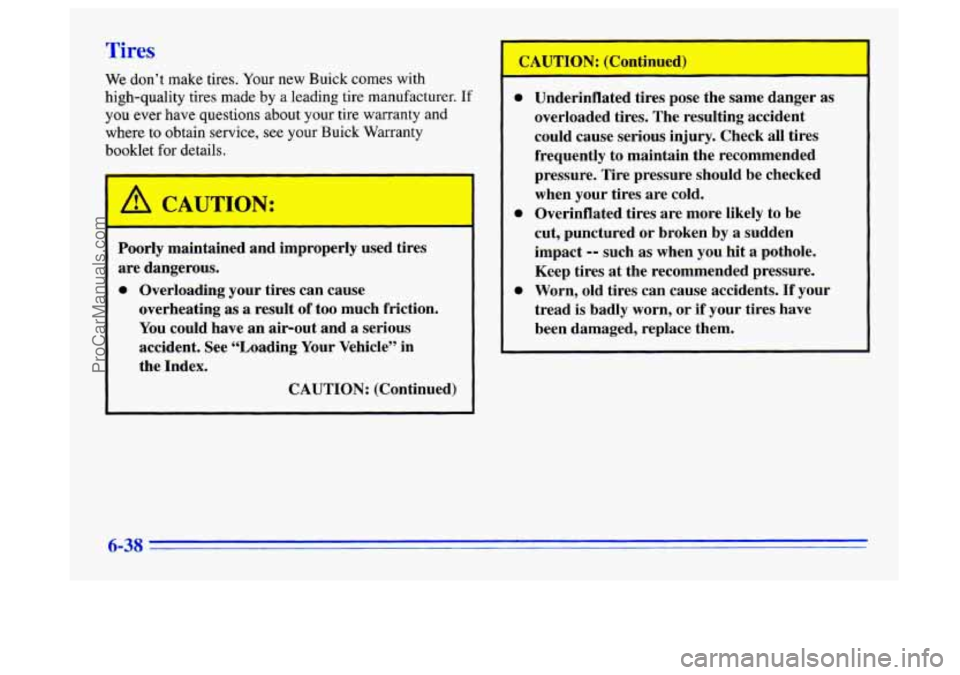
Tires
We don’t make tires. Your new Buick comes with
high-quality tires made
by a leading tire manufacturer. If
you ever have questions about your tire warranty and
where to obtain service,
see your Buick Warranty
booklet for details.
I A CAUTION:
Poorly maintained and improperly used tires
are dangerous.
0 Overloading your tires can cause
overheating as a result
of too much friction.
You could have an air-out and a serious
accident. See “Loading Your Vehicle” in
the Index.
CAUTION: (Continued)
CAUTION: (Continued)
0 Underinflated tires pose the same danger as
overloaded tires. The resulting accident
could cause serious injury. Check all tires
frequently to maintain the recommended
pressure. Tire pressure should be checked
when your tires are cold.
cut, punctured or broken by a sudden
impact
-- such as when you hit a pothole.
Keep tires at the recommended pressure.
0 Worn, old tires can cause accidents. If your
tread is badly worn, or if your tires have
been damaged, replace them.
0 Overinflated tires are more likely to be
6-38
ProCarManuals.com
Page 331 of 340
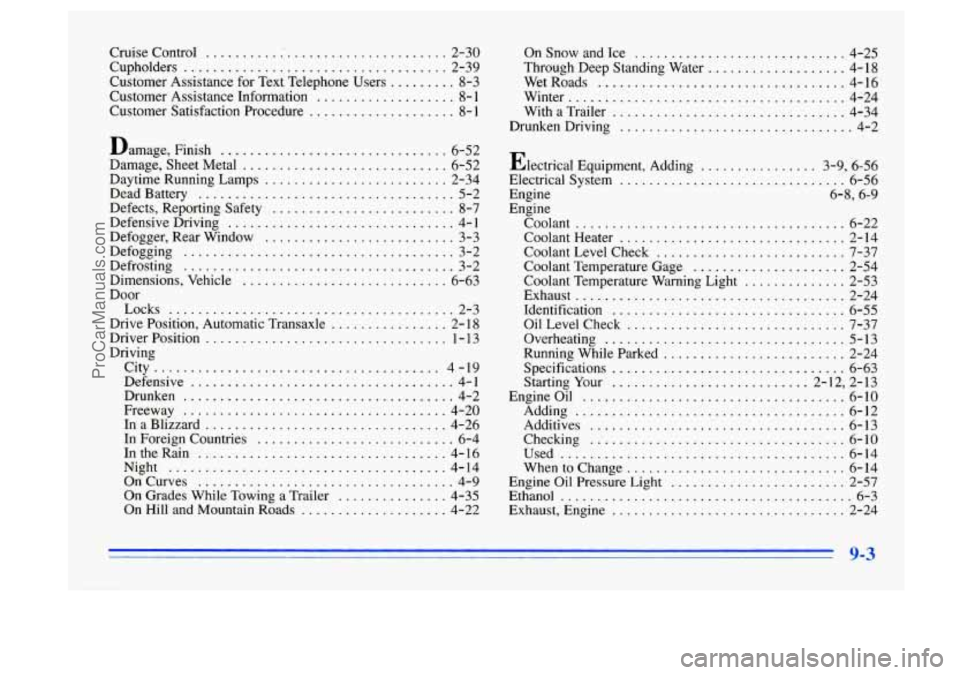
Cruise Control .................................. 2-30
Cupholders
.................................... 2-39
Customer Assistance Information
................... 8- 1
Customer Satisfaction Procedure .................... 8- 1
Damage. Finish ............................... 6-52
Damage. Sheet Metal
............................ 6-52
Daytime Running Lamps
......................... 2-34
Dead Battery
................................... 5-2
Defects. Reporting Safety
......................... 8-7
Defensive Driving
............................... 4- 1
Defogger. Rear Window
.......................... 3-3
Defogging
..................................... 3-2
Defrosting
..................................... 3-2
Dimensions. Vehicle
............................ 6-63
Door
Drive Position. Automatic Transaxle
................ 2- 18
Driver Position
................................. 1 - 13
Driving
City
....................................... 4-19
Defensive
.................................... 4-1
Drunken
..................................... 4-2
Freeway
.................................... 4-20
In a Blizzard ................................. 4-26
In Foreign Countries
........................... 6-4
IntheRain
.................................. 4-16
Night
...................................... 4-14
OnCurves
................................... 4-9
On Grades While Towing a Trailer ............... 4-35
On Hill and Mountain Roads
.................... 4-22
Customer Assistance for
Text Telephone Users
......... 8-3
Locks
....................................... 2-3 OnSnowandIce
............................. 4-25
Wet Roads
.................................. 4-16
Winter ...................................... 4-24
With a Trailer
................................ 4-34
DrunkenDriving
................................ 4-2
Electrical Equipment. Adding
................ 3-9. 6-56
Electrical System
............................... 6-56
Engine 6-8. 6-9
Engine
Coolant
..................................... 6-22
Coolant Heater
............................... 2-14
Coolant Level Check
.......................... 7-37
Coolant Temperature Gage
..................... 2-54
Exhaust
..................................... 2-24
Identification
................................ 6-55
OilLevelCheck
.............................. 7-37
Overheating
................................. 5-13
Running While Parked ......................... 2-24
Specifications
................................ 6-63
Starting Your
........................... 2- 12. 2-13
Engineoil
.................................... 6-10
Adding
..................................... 6-12
Additives
................................... 6-13
Checking
................................... 6-10
Used
....................................... 6-14
Whentochange
.............................. 6-14
Engine
Oil Pressure Light ........................ 2-57
Ethanol
........................................ 6-3
Through Deep Standing
Water
................... 4-18
Coolant Temperature Warning Light
.............. 2-53
Exhaust. Engine
................................ 2-24
9-3
ProCarManuals.com
Page 334 of 340
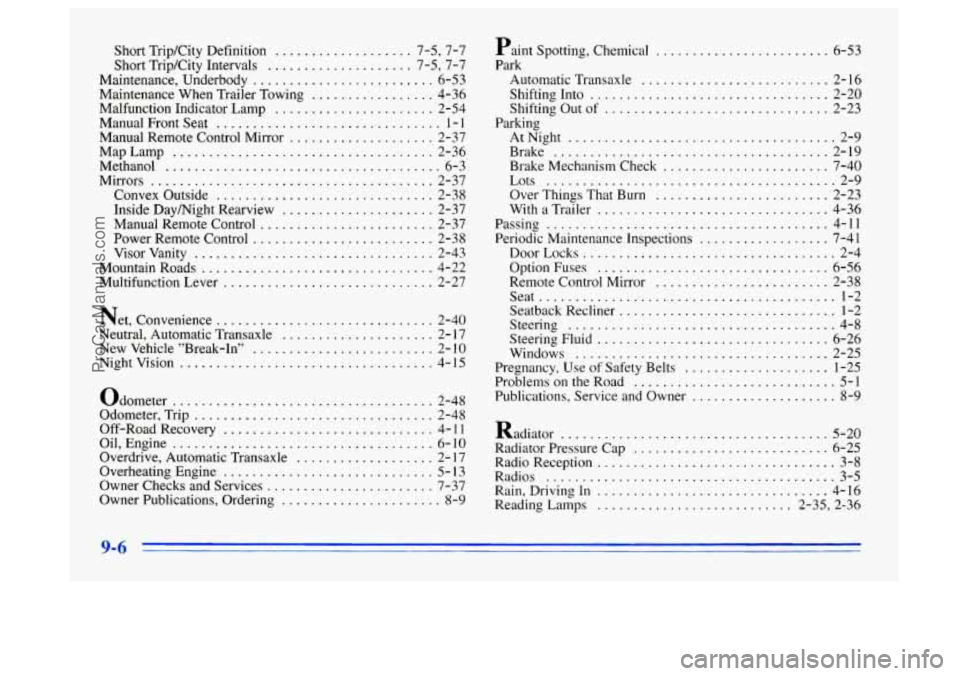
Short TripKity Definition ................... 7.5, 7.7
Short Trip/City Intervals
.................... 7.5. 7.7
Maintenance. Underbody
......................... 6-53
Maintenance When Trailer Towing
................. 4-36
Malfunction Indicator Lamp
...................... 2-54
Manual Front Seat
............................... 1 - 1
Manual Remote Control Mirror .................... 2-37
MapLamp
.................................... 2-36
Methanol
...................................... 6-3
Mirrors
....................................... 2-37
Convex Outside
.............................. 2-38
Inside Daymight Rearview
..................... 2-37
Manual Remote Control
........................ 2-37
Power Remote Control
......................... 2-38
Visor Vanity
................................. 2-43
MountainRoads
................................ 4-22
Multifunction Lever
............................. 2-27
Net. Convenience
.............................. 2-40
Neutral. Automatic Transaxle
..................... 2- 17
New Vehicle "Break-In"
......................... 2- 10
Nightvision ................................... 4-15
Odometer .................................... 2-48
Odometer. Trip
................................. 2-48
Off-Road Recovery
............................. 4- 1 1
Oil. Engine .................................... 6-10
Overdrive. Automatic Transaxle
................... 2- 17
Overheating Engine ............................. 5 - 13
Owner Checks and Services
....................... 7-37
Owner Publications. Ordering
...................... 8-9
Paint Spotting. Chemical ........................ 6-53
Park Automatic Transaxle
.......................... 2-16
Shifting Into ................................. 2-20
Shifting Out of
............................... 2-23
AtNight
..................................... 2-9
Brake
...................................... 2-19
Brake Mechanism Check
....................... 7-40
Lots
........................................ 2-9
Over Things That Burn
........................ 2-23
With
a Trailer ................................ 4-36
Passing
....................................... 4-11
Periodic Maintenance Inspections .................. 7-41
DoorLocks
................................... 2-4
Option Fuses
................................ 6-56
Remote Control Mirror ........................ 2-38
Seat
......................................... 1-2
Seatback Recliner
.............................. 1-2
Steering
..................................... 4-8
Steering Fluid
................................ 6-26
Windows
................................... 2-25
Pregnancy. Use
of Safety Belts .................... 1-25
Problems on
the Road ............................ 5-1
Publications, Service and Owner .................... 8-9
Parking
Radiator
..................................... 5-20
Radiator Pressure Cap
........................... 6-25
Radio Reception
................................. 3-8
Radios ........................................ 3-5
Rain. Driving In ................................ 4-16
Reading Lamps
........................... 2-35. 2.36
9-6
ProCarManuals.com